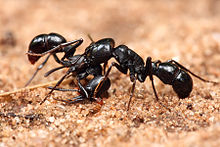Loading AI tools
Genus of ants From Wikipedia, the free encyclopedia
Plectroctena is an Afrotropical genus of ants, with most species occurring in the rainforest zones of West and Central Africa.[2] Some species are cryptic or subterranean foragers,[2] while others forage in open grassland terrain. The workers forage singly[3] or in groups of 2 to 3.[4] They nest in the earth at varying depths, or in collapsed logs. They prey mainly on millipedes, including their young or eggs.[2]
| Plectroctena | |
|---|---|
 | |
| Two workers in Tanzania | |
| Scientific classification | |
| Domain: | Eukaryota |
| Kingdom: | Animalia |
| Phylum: | Arthropoda |
| Class: | Insecta |
| Order: | Hymenoptera |
| Family: | Formicidae |
| Subfamily: | Ponerinae |
| Tribe: | Ponerini |
| Genus: | Plectroctena F.Smith, 1858 |
| Type species | |
| Plectroctena mandibularis F.Smith, 1858 | |
| Diversity[1] | |
| 17 species | |
| Synonyms | |
|
Cacopone Santschi, 1914 | |

A colony of P. lygaria (a small species of the mandibularis-group) may number in excess of 300 adults. An excavated colony in the Ivory Coast consisted of 277 workers, 8 alate queens, and 42 alate males. Consequently 15% of their number was allocated to reproductives at the specific time.[2] The colony size of P. mandibularis however, seldom exceeds 50 individuals.[2][3]
In a colony of P. lygaria, the nest chambers are located at shallow depth, in moist soil under dense leaf litter. The deepest chamber may be located about 7 cm below the surface, with each chamber up to 1 cm in height.[2] The chambers are specialized to house either brood or prey items. Nests of the widespread species P. mandibularis however, are composed of chambers typically located 2 feet or more below the surface, with entrances that are usually marked by large piles of earth.[3][2]
It is believed that millipede eggs may at times constitute the exclusive diet of P. lygaria,[2] while newly emerged millipede young may be an additional food source for the smaller Plectroctena species. Larger species like P. conjugata, P. mandibularis and P. minor specialize on adult millipedes.[2]
Seamless Wikipedia browsing. On steroids.
Every time you click a link to Wikipedia, Wiktionary or Wikiquote in your browser's search results, it will show the modern Wikiwand interface.
Wikiwand extension is a five stars, simple, with minimum permission required to keep your browsing private, safe and transparent.